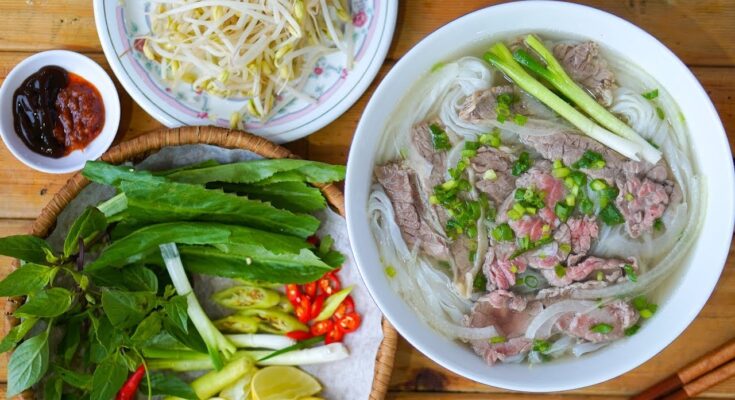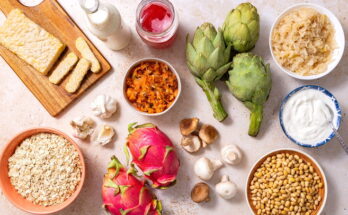Pho Recipe: Pho (pronounced “fuh”) is a traditional Vietnamese soup made with a savory broth, rice noodles, fresh herbs, and protein options like beef or chicken. It’s a comforting dish, deeply rooted in Vietnamese culinary tradition, and loved for its rich, aromatic flavors.
This dish is more than just a meal—it’s an experience. With its enticing aroma and vibrant garnishes, pho is the ultimate comfort food that transcends boundaries.
Origin and Cultural Significance of Pho
Pho originates from Vietnam, specifically from the northern region in the early 20th century. It quickly gained popularity due to its affordability and nourishment. Over time, it spread across the globe, becoming a symbol of Vietnamese cuisine.
Why is Pho So Popular?
Pho is beloved for its versatility and flavor. It’s a dish that allows customization, making it perfect for various dietary preferences. Whether you’re enjoying a steaming bowl on a chilly day or seeking something light and flavorful, pho never disappoints.
Ingredients Needed for Making Pho
Essential Ingredients for the Broth
- Beef or Chicken Bones: The foundation of a rich broth.
- Aromatic Spices: Star anise, cloves, cinnamon sticks, cardamom, and coriander seeds.
- Onion and Ginger: Roasted for depth and complexity.
- Fish Sauce and Sugar: For that signature umami kick.
Protein Options for Pho
- Beef: Thinly sliced sirloin, brisket, or meatballs for Pho Bo.
- Chicken: Shredded chicken or poached chicken for Pho Ga.
- Tofu or Mushrooms: For vegetarian and vegan options.
Fresh Herbs and Garnishes
- Herbs: Thai basil, cilantro, and scallions.
- Garnishes: Lime wedges, bean sprouts, sliced chili, and hoisin or sriracha sauces.
Tools and Equipment Required
Kitchen Essentials for Preparing Pho
- Large Stockpot: For boiling the broth.
- Fine Mesh Strainer: To remove impurities from the broth.
- Sharp Knife and Cutting Board: For slicing ingredients precisely.
Tips for Simplifying the Cooking Process
- Use pre-packaged spice kits for pho if you’re short on time.
- Opt for a pressure cooker to reduce broth preparation time.
Step-by-Step Instructions to Make Pho
Step 1 – Preparing the Broth
- Roast Aromatics: Char onion and ginger under a broiler for 5 minutes.
- Simmer Bones and Spices: Add bones to a large stockpot with water, spices, and aromatics. Simmer for at least 4 hours.
- Season the Broth: Add fish sauce, sugar, and adjust salt to taste.
Step 2 – Preparing the Noodles
- Soak rice noodles in warm water for 30 minutes.
- Boil noodles briefly in hot water until tender.
- Rinse with cold water to stop cooking.
Step 3 – Assembling Your Pho Bowl
- Place cooked noodles in a bowl.
- Add sliced protein on top.
- Ladle hot broth over noodles and protein.
- Garnish with herbs, bean sprouts, lime, and sauces.
Variations of Pho
Beef Pho (Pho Bo)
Pho Bo is the classic version of pho, featuring thinly sliced beef as the primary protein. This variation typically uses a rich beef bone broth, infused with spices like star anise and cloves. Common cuts of beef include sirloin, brisket, or flank steak. For added texture, some recipes include beef meatballs or tendon.
To make Pho Bo:
- Prepare a beef-based broth, simmering bones and aromatics for hours.
- Add thin slices of raw beef directly into the bowl before ladling hot broth on top, which cooks the meat to tender perfection.
Chicken Pho (Pho Ga)
Pho Ga offers a lighter alternative to the beef version. The broth is made by simmering chicken bones, often with the addition of fish sauce and ginger to enhance flavor.
Steps to make Pho Ga:
- Poach chicken and shred it into bite-sized pieces.
- Serve with rice noodles, chicken broth, and the usual fresh garnishes.
This version is perfect for those who prefer a milder, less fatty soup.
Vegetarian and Vegan Pho
For plant-based enthusiasts, vegetarian pho is a flavorful delight. The broth is made with a combination of charred onion, ginger, and vegetables like carrots, daikon, and mushrooms. Instead of meat, tofu, seitan, or an assortment of vegetables are used.
To enhance the depth of flavor:
- Incorporate soy sauce or tamari for umami.
- Add a variety of mushrooms for a meaty texture.
Tips for Perfecting Your Pho
Balancing the Flavors
Pho’s magic lies in its balanced combination of salty, sweet, sour, and umami flavors. To achieve this:
- Taste the broth frequently and adjust seasoning with fish sauce, sugar, or lime juice.
- Avoid overpowering the delicate spices by over-boiling them.
Common Mistakes to Avoid
- Skipping the Roasting Step: Charring the onion and ginger is crucial for depth of flavor.
- Using Store-Bought Broth: While convenient, it lacks the complexity of a homemade broth.
- Overcooking the Noodles: Always rinse them under cold water to prevent further cooking.
How to Serve Pho Like a Pro
Presentation is everything! Arrange noodles neatly, place protein atop the noodles, and garnish artfully with herbs and sprouts. Serve condiments like hoisin and sriracha on the side for individual customization.
Health Benefits of Pho
Nutritional Value of Pho
Pho is nutrient-dense, thanks to its blend of protein, vegetables, and herbs. It’s low in calories but high in vitamins and minerals:
- Proteins: From beef, chicken, or tofu, support muscle repair.
- Herbs: Basil and cilantro provide antioxidants.
- Broth: Packed with collagen and nutrients from the simmered bones.
How Pho Supports a Balanced Diet
Pho can fit seamlessly into various dietary lifestyles:
- Opt for lean proteins like chicken for a lower-calorie meal.
- Load up on bean sprouts and fresh herbs to increase fiber intake.
- Customize your bowl with less salt or sodium-free sauces for a heart-healthy option.
Storing and Reheating Pho
Storing the Broth and Noodles Separately
To keep your pho fresh:
- Refrigerate the broth and noodles in separate containers to prevent sogginess.
- Store garnishes like herbs and sprouts in airtight containers.
Best Practices for Reheating
Assemble the bowl fresh, just like when serving it the first time.
Heat the broth in a saucepan until it simmers.
Briefly dip noodles in hot water to reheat without overcooking.
FAQs about Pho Recipe
Can I make pho in advance?
Absolutely! Pho broth gets better with time. Prepare it a day or two ahead and store it in the refrigerator. Reheat and assemble the noodles and toppings when ready to serve.
How do I store leftover pho?
Keep the broth, noodles, and toppings in separate containers. Combine them only when reheating to preserve their texture and flavor.
What makes pho different from ramen?
Pho features a lighter, clearer broth with rice noodles and fresh herbs, while ramen is heartier, with wheat noodles and a more robust, fatty broth.
Can I freeze pho broth?
Yes, pho broth freezes beautifully. Store it in airtight containers for up to three months. Thaw and reheat for a quick meal.
What are some vegetarian alternatives for pho?
Tofu, seitan, or even jackfruit can be excellent substitutes for meat. Focus on the broth’s depth by incorporating umami-rich ingredients like soy sauce or dried mushrooms.
Conclusion
Making pho at home might seem intimidating, but with the right ingredients and steps, it’s entirely achievable. The result? A deeply satisfying and aromatic bowl of soup that will transport your taste buds straight to Vietnam. Whether you’re a pho novice or a seasoned chef, this guide will help you master the art of pho-making.
Just your feedback is enough for me! Please take a moment to leave a review.



